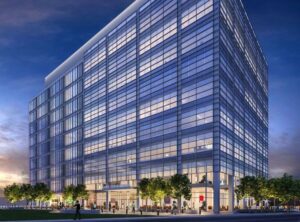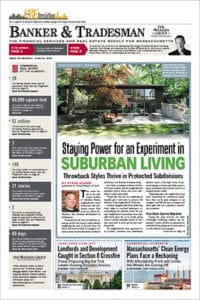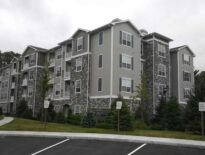
Leggat McCall Properties and DLJ Real Estate Capital Partners broke ground this summer on Somerville’s 101 South St., a speculative 289,000-square-foot class A lab building, as they seek to establish Union Square as a new life science cluster. Image courtesy of Leggat McCall Properties
Greater Boston’s life science industry is thriving. Employment has never been higher. Venture capital, corporate partnerships and academia continue to fund life-saving research and development. And scientific breakthroughs are a common occurrence.
Kendall Square has long been, and will remain for the foreseeable future, the epicenter of the local, national and global biotech and life science market. This tremendous success has led to airtight vacancies and record-high rental rates in Kendall. New development has filled up prior to completion, and we have seen achieved lab rents top $125 per square foot on a triple-net basis.
All of this has led tenants, landlords and investors to look to secondary clusters nearby.
Inventory Grows on 128
Suburban markets such as Lexington, Waltham, Watertown and Woburn have long been established lab clusters and are being targeted for additional development, either ground-up or through conversion.
Numerous suburban properties are being eyed for full lab conversion or lab-ready shell. Lexington, Waltham and Burlington are areas of particular focus for conversion. The number of players in the lab/life science real estate space has exploded in recent years, profoundly changing the market for tenants. Properties, once highly concentrated in the hands of a few players, are now owned by a wider set of landlords.
This level of activity has also caused the suburban inventory to grow at the same time. On the ground-up development side, new construction in Watertown is helping to set new high-water marks for suburban lab space rents.
But the focus today is starting to shift closer to Kendall, directly along transit lines. We have already seen the transformation at Cambridge Crossing and the strong leasing there to date. The Green Line Extension will open access and connectivity in Somerville beyond the Orange Line, priming it to become a competitive life science market. Today there is just one biotech firm in Somerville, which lacks lab product at the moment, but new construction will allow biotech to grow there. Development at Boynton Yards, Union Square, Xmbly and Assembly Row will bring new lab and office product to the market.
Next Stop, Broadway
Across the Charles, Boston is getting in on the action. The Seaport has been ground zero for lab inventory, though downtown has received its share of biotech and life science companies. These firms generally lack lab-specific requirements, so the value of a class A building downtown compared to one in Cambridge is a compelling story: rents in the $60s to $70s per square foot gross stack up quite well against nearly $100 per square foot rates, just a couple of stops away on the Red Line.

Aaron Jodka
Speaking of the Red Line, the MBTA’s Broadway stop will be key to creating the next life science cluster in Boston in the A Street corridor. Numerous life science players have invested heavily in land sites or existing assets, with plans to build more than 1 million square feet of new product, along with mixed-use supporting development.
But the A Street Corridor isn’t the only new frontier within Boston’s boundaries. Allston-Brighton is also aiming for a piece of this growing industry, with long-term plans by Harvard University to create an ecosystem of life science and academic research. This will be a few years away, as Harvard’s plans rely on the realignment of the Massachusetts Turnpike.
The life science industry is now a key driver of the local economy. The new development totaling millions upon millions of square feet of new product will continue to provide the space that these innovative companies need to thrive and create their next breakthroughs.
Aaron Jodka is managing director of client services for Colliers International in Boston.





